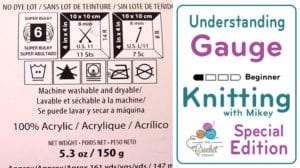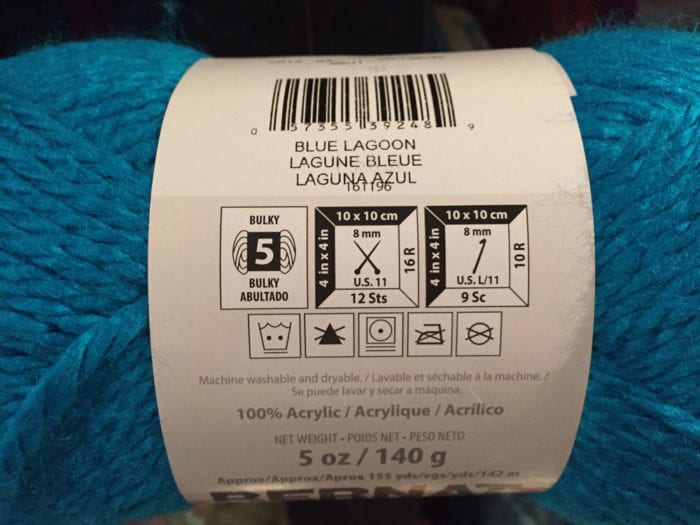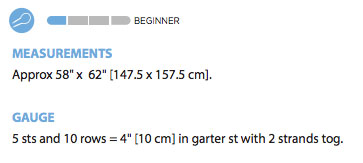
Understanding How to Find Knit Gauges
Gauge and Tension are both related to each other. Those instructions can be found in two places depending on the yarn brand you have selected.
Most of the major yarn makers provide this information on the ball band. Though many people gloss over when they turn over the ball band to read this information, it's really there to be your guide.
Suggestions
- What To Do With Caron Jumbo Yarn
- What To Do with Bernat Velvet Yarn
- What To Do With Caron Latte Cakes
- Knitting Tools and Gadgets + Tutorial
- What To Do with Caron X Pantone Yarn?
What is the Gauge?
Gauge is the counting of stitches and rows within a square. Today, most gauges are provided in 4" x 4" squares. If you see the ball band, you will see that marked on the left side of the gauge box of 4 in x 4 in. For those in metric, 10 cm x 10 cm is really super close to the same size. You will see the metric on the top of the gauge box.
Gauge Width
The bottom box shows 11 sts. This is telling you that within a 4" span across the project, there should be 11 sts if using 8 mm or U.S. 11 Knitting Needle.
Gauge Height
The right-hand side of the box has 14 R. That means 14 rows. So for the 4" span in the height using the 8 mm or U.S. 11 Knitting Needle, there should be 14 rows.
How to Determine if you are a Tight or Loose Knitter?
Tight Knitters
The measurement we gave you 11 sts in the width.
- If you have more than 11 sts in the width for the same 4" span. It means you were able to make more stitches to fit into the 4". So anything above the 11 sts means you are a tight knitter.
- Tight knitters will always create projects that are too small if you stick to the same hook size and don't change anything. For hats or items that fit something, this will create problems.
- If this is your consistency, you have to move up knitting needle sizes and swatch again to find your own personal gauge. This is not abnormal.
Loose Knitters
The measurement we gave to you is 11 sts in the width.
- If you have less than 11 sts in the 4" in the span. It means you were not able to get 11 sts into the 4" and that your stitches were bigger than the recommendation. This is means you are a loose knitter.
- Though you may be using the prescribed knitting needle size, you will have to reduce your knitting needle size to get to the gauge suggested. This means for any size of projects you do, your project will always be too big.
- As a personal testament to this, I am a loose crocheter and know this from the way I crochet and how relaxed I crochet.

What Determines your Personal Gauge?
Your own body and mindset determine your personal gauge. Your stress level, chair, the motion of your hands, location of yarn ball feeding work and more determine if you are loose, just right or tight.
For myself, if I watching a movie that keeps me mentally on edge, I find my projects are tighter for the span that I made during the time frame.
Generally speaking, I am a loose crocheter which may equate to be a loose knitter. The motion of hands is relaxed with little tension. I don't think much and let my hands do the motions. I find I am tighter if I am nervous about a stitching technique or unsure of the pattern. Usually, the second time I do something the project is my typical gauge.
Why Do Designers Share the Gauge?
If the designer of a pattern insists that the blanket is 42" x 42". They have given their pattern to you. The only way you can know for sure how to match exactly the same size is to pay attention to the gauge.
If the designer were to give you the size and pattern without a gauge. Many of us would not get the same dimensions of the finished project by the designer.
The gauge is measured directly from the sample in the 4" x 4" or 10 cm x 10 cm, square size.
Gauge instructions are important for matching exactly what a pattern is suggesting.
The gauge on Yarn Balls
Through the professional development of the yarn company, the company assigns the yarn the standard of gauge by testing and having previous knowledge of similar thicknesses of yarn in stock to cross-compare. In the example in the banner photo and below for the ball band, that is Bernat Softee Chunky. Let's take a moment to read it.
For the knitting side of the gauge. Bernat has determined their yarn is an 8 mm or U.S. 11 Knitting Needle. There is no difference in that size. Canada uses the metric system which is identified by millimetres in diameter of the knitting needle. The other one is the U.S. 11, which is the size of the needle assigned for U.S. Marked Knitting Needles. You will see the same for the crochet hook.

Gauge on Pattern
Professional patterns where the design has given the gauge information. The picture below is pulled from a Yarnspirations pattern where the designer has shared how many stitches and rows are in the 4" or 10 cm square.
So when doing this pattern you are loose if the stitches are as follows:
- Loose Knitters are less than 4 sts or less per 4" or 10 cm span. Reduce knitting needle size.
- Perfect gauge if you have 5 sts in the 4" or 10 cm span. Keep going.
- Tight Knitters are if you have 6 or more sts in the 4" span. Increase knitting needle sizes
You have to test yourself on swatches as there really isn't a magic number to get the correct gauge. Only through experienced knitting and knowing yourself can you make assumptions and be the correct first time. It's trial and error.

Pattern Gauge is King
If you have a gauge on both yarn ball and on the pattern. The pattern is king. It is the final say on what your gauge should be.
- Knitting stitches are not equal in tension. So different stitches may be different sizes even though the same needle may be used.
- Stitches can be tight through how they are made or they can be loose if the stitch is produced a different way. Projects can have different stitches used throughout the project.
- Always follow the pattern gauge.
Tutorial
https://www.youtube.com/watch?v=1dt_QWTWTh0
Leave me your thoughts...